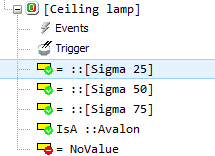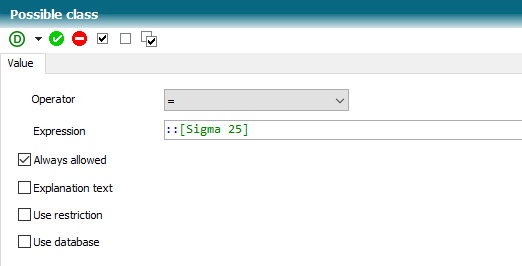

After classes are applied as possible values for an object, they are available in the classes tree for further editing.


|
Property |
Description |
|
Operator |
A possible comparison operator for the class expression. |
|
Expression |
An expression that represents a class name. |
|
Always allowed |
If the switch is set, the class is always valid and can be invalidated by a prohibition rule if necessary. If the switch is not set, the class can be validated by a permission rule. |
|
Explanation text |
Once the switch is set, a manually formulated explanatory text can be stored (e.g. via a text constant). |
|
Use restriction |
If the switch is set, the restriction function can be edited in another register. |
|
Use database |
If the switch is set, a database access for possible classes can be determined in another register. |
|
Remarks |
Developer comments. |
Rules
 A
permission rule can be created by clicking on it. A permission rule determines
the conditions under which the class is displayed as valid. A permission rule is
only useful if the Always Allowed switch is switched off for the possible
class.
A
permission rule can be created by clicking on it. A permission rule determines
the conditions under which the class is displayed as valid. A permission rule is
only useful if the Always Allowed switch is switched off for the possible
class.
 A
prohibition rule can be created by clicking on it. A prohibition rule determines
the conditions under which the class is displayed as invalid.
A
prohibition rule can be created by clicking on it. A prohibition rule determines
the conditions under which the class is displayed as invalid.
 By
clicking on it, an assignment rule can be created. An assignment rule assigns
the class to the object. Assignment rules should be sparsely used and better use
decision controls to avoid infinite loops.
By
clicking on it, an assignment rule can be created. An assignment rule assigns
the class to the object. Assignment rules should be sparsely used and better use
decision controls to avoid infinite loops.
 A delete
rule can be created by clicking on it. A delete rule deletes the class from the
object. This is particularly useful for object lists. Deletion rules should be
sparsely used and better use decision controls to avoid infinite loops.
A delete
rule can be created by clicking on it. A delete rule deletes the class from the
object. This is particularly useful for object lists. Deletion rules should be
sparsely used and better use decision controls to avoid infinite loops.
 By
clicking on it, an assignment/delete rule can be created. It assigns the class
to the object when the rule is met and deletes the object again if the rule is
not (no longer) met. Assignment/delete rules should be sparsely used and better
use decision controls to avoid infinite loops.
By
clicking on it, an assignment/delete rule can be created. It assigns the class
to the object when the rule is met and deletes the object again if the rule is
not (no longer) met. Assignment/delete rules should be sparsely used and better
use decision controls to avoid infinite loops.
Restriction
The constraint function is used to limit the number of selectable classes. This is especially necessary if the class deposited in the Expression property has derived classes and has been specified as an IsA or NotIsA operator.
For each of the found classes, the restriction function is then passed through.
The back value of the function determines whether the class should be used. True uses the class, but False does not.
The Class parameter identifies the class to be tested. The variable is of type Class.
The reference parameter determines whether the class should be displayed as disabled when used.

Database
A database connection can be used to determine class names to be used as possible derived classes.

|
Property |
Description |
|
Connection |
A database connection defined in the properties of the knowledge base. |
|
Column |
A field from the SQL statement below to be used as the class name. |
|
Prefix |
A text that can be preceded by the class name. This is especially necessary if the ODBC classes that may be restricted here also have a prefix specified in the ODBC parameters of class selection. |
|
SQL |
SELECT Statement on the selection of the classes to be used for the object. |